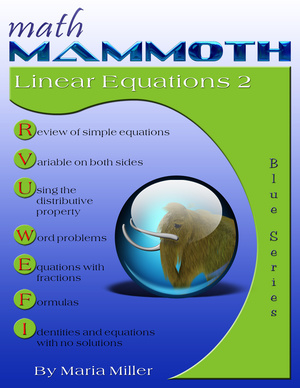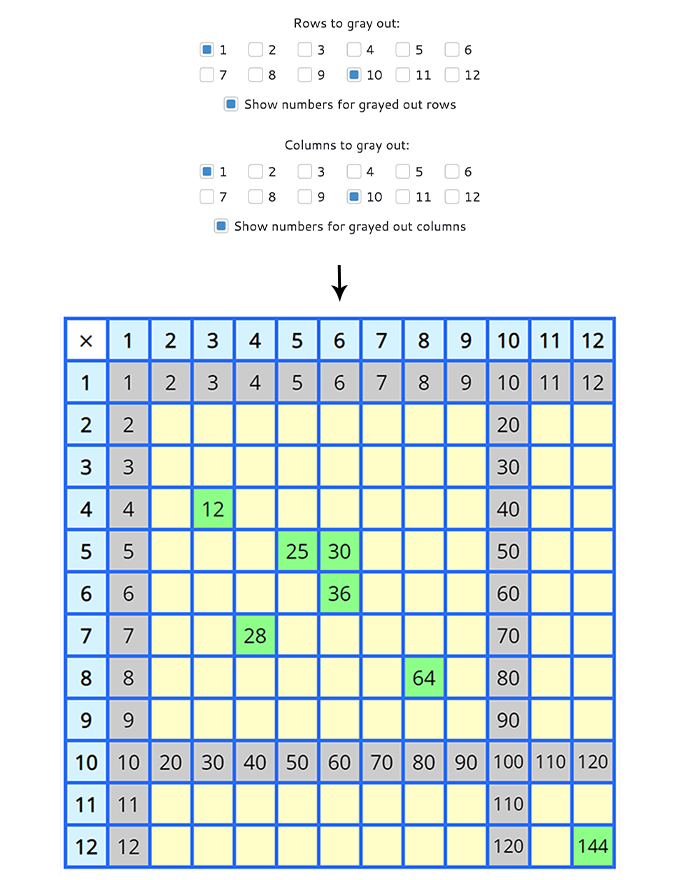 Hello!
Hello!
Welcome again! 😀 |
1. Math Mammoth news Another book in the Blue Series for 8th grade: Math Mammoth Linear Equations 2.
Math Mammoth Linear Equations 2 continues the study of linear equations after Math Mammoth Linear Equations 1, and is meant for the 8th grade level. It focuses both on the mechanics of solving linear equations (incl. equations with fractions) and on problem solving.
Another book in the Blue Series for 8th grade: Math Mammoth Linear Equations 2.
Math Mammoth Linear Equations 2 continues the study of linear equations after Math Mammoth Linear Equations 1, and is meant for the 8th grade level. It focuses both on the mechanics of solving linear equations (incl. equations with fractions) and on problem solving.
Sample pages (PDF) |
2. The times tables, once and for allSince October is the time for many students to be working on the multiplication tables, I thought I would list here the resources available at Mathmammoth.com. Most of these are FREE.
|
3. Word problemsRecently, someone asked me about WORD PROBLEMS (once again...)."My son is in 8th grade but working through MM6. However, he is struggles to identify steps and operations for word problems. Since word problems spiral throughout the entire program, how would you suggest remediating this? (To be frank, I have always struggled with this myself). I'm glad this person has pinpointed the problem, as it's quite important to be able to understand and solve word problems. However, it's not necessarily quick to remediate. Basically, you might want to start the student with easy word problems first (2nd grade level perhaps?), practice those, and then build up. You could use the word problems in my placement tests to gauge what level the student can handle easily and where his problems start. We don't currently have a book consisting solely on word problems (though the plan is to produce some in the future). For now, the best I can offer, using Math Mammoth materials, is to purchase various books from the BLUE series, and have him do word problems in them. Another way might be to use Khan Academy's word problems starting from 2nd, 3rd, or 4th grade onward. This article of mine sheds light on "the problem with word problems". It mentions for example Ray's Arithmetic — that book should definitely help one to learn to solve word problems, because it contains SO many, and it's free. 😀 |
4. Fourth grade SDC class achieves tremendous gains in math using newspapers(Maria's note: This is a true and inspiring story of a good teacher making a huge difference in these children's lives! It was an entry to my Math Moments contest in early 2014. And yes, she did win some Math Mammoth materials! I hope you enjoy the story as much as I did.)By Sylvia Everett In 1998 I received my first teaching position, a fourth grade SDC class (Special Day Class) in one of the most dangerous parts of Northern California. The children had previously been confined to the cafeteria and sometimes even locked in to prevent runaways. I was given two aides who while they tried their best both were barely literate themselves. It was hell and heaven. The kids had never had a teacher who spoke their own home language and this immediately created a bond between us as well as enabling parents to freely communicate with me. I was given a room and allowed to scour the school to use whatever anyone else wasn’t using, which was a blessing as I had not built up the stores of needed materials that are a teachers mainstay. I can only imagine if I had the Math Mammoth series what other major changes I could have made in their lives.  Within weeks we were adding up multiple numbers they had written themselves. We could put values to coins and bills. They were able to play store in the classroom and at home.  I was able to move into other areas of mathematics and allowed the children to continue the newspaper exercise as a homework practice. My children had seen that math was not something to be hated, but something that was all around them and in every aspect of their lives. Parents were amazed that their children could not only understand the concept of numbers, but had helpmeets in their shopping and children who were realizing the value of a dollar.  I was blessed with being in these children’s lives for 3 years in one way or another. At every step I scrambled for material. I spent hours and hours trying to create relevant and purposeful lesson. Teaching is hard work and any possible advantage a teacher receives benefits her students. To be handed materials like Math Mammoth was a dream. I can be thankful for what I accomplished with what little I had, but I can also see what the possibilities could have been if I had been properly supplied. Sylvia Everett |
5. MatheMagicThis is an amazing performance of "mathemagic" — calculating things in one's head by Arthur Benjamin. He not only can calculate but also ENTERTAIN, so this video is sure to captivate you! I enjoyed it a lot, and all my children watched it, even multiple times.:)Benjamin first squares a 2-digit number in his head — faster than the audience members with calculators can do it. He takes it a step further, and squares a 3-digit number in his head, again racing against calculators! And... he takes it a step further yet! Benjamin also figures out what day of the week the birthdays of some audience members were and performs a few other tricks. I encourage you to watch the whole video — you'll enjoy it! The most interesting part might be the very end, where he takes on the challenge of squaring a five-digit number — AND explains how he does it! And it's not "magic" as such; it's based on solid mathematical principles that we all use when multiplying numbers on paper. To square any number n, he breaks it into two parts (a + b) and then uses this principle: (a + b)2 = a2 + 2ab + b2, which is all too familiar to algebra students. To keep the partial results in his mind, he uses WORDS to represent numbers and memorizes the words instead of the partial results. I found that quite interesting and clever! |
6. Just for fun!
Thanks for reading! 🙂 Feel free to forward this issue to a friend/colleague! Subscribe here. Till next time, Maria Miller |
| Privacy & your personal data | Contact | Math Mammoth freebies | Placement tests |
| Complete curriculum | Pathway To Resurrection | Visit us on Facebook | Newsletter Archives |
